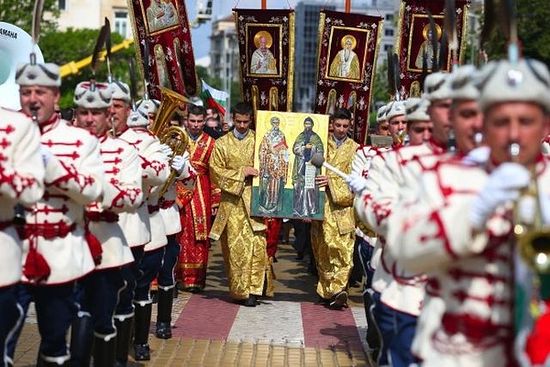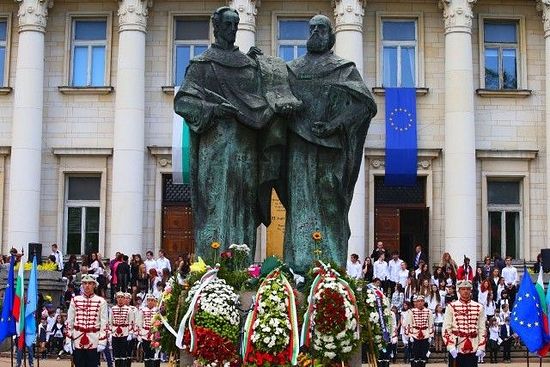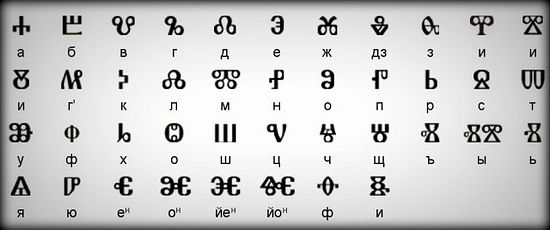BULGARIA CELEBRATES DAY OF BULGARIAN (CYRILLIC) ALPHABET AND CULTURE (DAY OF STS. CYRIL AND METHODIUS)
Archaeology in Bulgaria – May 2016
Bulgaria and Bulgarians around the world celebrated on May 24, 2016, the Day of St. Cyril and St. Methodius, i.e. the Day of the Bulgarian Alphabet (more widely known internationally as the Cyrillic) and Bulgarian Culture, one of the country’s official national holidays.
The Bulgarian alphabet, or the Cyrillic, as it is better known internationally, was developed at the end of the 9thcentury AD for the Old Bulgarian language, sometimes referred to today as Church Slavonic, possibly at the Preslav Literary School and/or the Ohrid Literary School in the First Bulgarian Empire by St. Kliment Ohridski and St. Naum Preslavski.
St. Kliment Ohridski (St. Clement of Ohrid) and St. Naum Preslavski are two of the five major disciples of St. Cyril and St. Methodius, the Byzantine diplomats and civil servants of Slavic (i.e. Bulgarian) origin who invented the first Slavic alphabet, the Glagolitic, in 855 AD or 862 AD.
In 886 AD, the Glagolitic alphabet was brought to the First Bulgarian Empire by three of the disciples of St. Cyril and St. Methodius after they were chased away from the Central European kingdom of Great (today’s Czech Republic and Slovakia) by the Catholic Germanic clergy.
In Bulgaria, the disciples of the great Byzantine scholars, themselves Bulgarians, likely developed the new Bulgarian alphabet based on the Glagolitic, and allegedly called it Cyrillic in honor of their master, St. Cyril. Later Bulgarian clergymen, scholars, and missionaries spread their alphabet to other Slavic nations such as Russia and Serbia.
The Cyrillic (Bulgarian) alphabet is used today by some 300 million people in 12 countries in Eastern Europe and Northern and Central Asia, which are Slavic countries or non-Slavic countries that have been under Russian cultural influence, such as Mongolia which adopted the Cyrillic alphabet in the 1940s.
After Bulgaria joined the European Union on January 1, 2007, the Bulgarian (Cyrillic) alphabet became one of the three official alphabets of the EU, together with the Latin and Greek alphabets, a situation not unlike the Middle Ages when Europe was dominated by Latin, Greek, and Old Bulgarian, and their respective alphabets.
Summarizing the history of the Glagolitic and the Cyrillic as “two Bulgarian alphabets” Institute for Bulgarian Language of the Bulgarian Academy of Sciences notes that there is no consensus among historians whether the first Bulgarian alphabet, the Glagolitic, was invented in 855 AD or in 862 AD.
However, it is a known historical fact that it was invented by St. Cyril (also known as Constantine-Cyril the Philosopher), and that in 862 AD, the then Byzantine Emperor asked the two brothers, St. Cyril and St. Methodius, to translate the Christian literature into the Slavic language for their mission to the Central European state of Great Moravia (in today’s Czech Republic and Slovakia).
The Glagolitic was the work of St. Cyril who is often described as a “genius philologist”. The Glagolitic had a completely original graphic system in which every letter stood for one sound, and the letters for close sounds had similar depictions.
Irrefutable evidence that St. Cyril was the author of the first Bulgarian alphabet, the Glagolitic, is found in a Latin document called the Salzburg Memorandum of 871 AD which says that St. Methodius came to Pannonia with the «newly invented Slavic letters”.
St. Constantine-Cyril the Philosopher created the Glagolitic alphabet based on the Slavic dialect spoken around Salonica, today’s Thessaloniki in Greece, which belongs to the East Bulgarian Rupi Dialects. This is taken as evidence that the saintly brothers were ethnic Bulgarians. The Glagolitic letters used the three holy signs of Christianity – the cross, the circle, and the triangle (i.e. the Trinity) – for its letters.
The literary language created by St. Cyril and St. Methodius in the middle of the 9th century AD was Bulgarian, the so called Old Bulgarian, also known today as Church Slavonic. It was first spread in Moravia and Pannonia in Central Europe, albeit only for a brief period of time, before the Germanic Catholic clergy supplanted it with Latin.
After the death of St. Methodius in 885 AD, the five disciples of St. Cyril and St. Methodius were chased away from Great Moravia by the Germanic Catholic clergy, and three of them found shelter in the court of Knyaz Boris I Mihail, ruler of the First Bulgarian Empire (r. 852-889; 893 AD).
Thus, the second Old Bulgarian alphabet known today internationally as the Cyrillic was created at the end of the 9th century AD, possibly in the Bulgarian capital Veliki Preslav (“Great Preslav”). Unlike the Glagolitic, it contained 24 letters based on the letters of the Ancient Greek alphabet plus 14 letters similar to some of the Glagolitic letters which stand for the purely Bulgarian (Slavic) sounds: Б, Ж, З, Ш, Щ, Ч, Ц, Ъ, Ь, İ, ť, ™, Ю, Ы.
The author of the Cyrillic alphabet is technically unknown even though some scholars believe that it was St. Kliment Ohridski (St. Clement of Ohrid). He perfected the Glagolitic which had been created by his revered teachers, St. Cyril and St. Methodius.
According to the Institute for Bulgarian Language, the Bulgarian alphabet (Cyrillic) is more likely to have originated with the early medieval scholars from the Preslav Literary School because the incorporation of Greek letters appears to be connected with the old tradition in which government documents in the First Bulgarian Empire prior to the invention of the Glagolitic were recorded with Greek letters. However, in the Cyrillic alphabet they were adapted with the adding of the Glagolitic letters that were used for the specific Bulgarian (Slavic) sounds.
The Bulgarian alphabet is a unique cultural invention that paved the way for the progress and development not just of medieval Bulgaria but also of much of the rest of Europe. Many believe that its proper name must be «Bulgarian” or “Bulgaric alphabet”, and that the name “Cyrillic” was promoted internationally during the Modern Age by Russia as the Russian Empire and later the Soviet Union would not admit under any circumstances that their powerful empire used an alphabet created by a nation which, regardless of its medieval glory, is much smaller and less influential in modern times.



